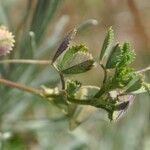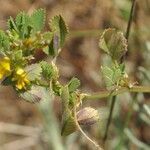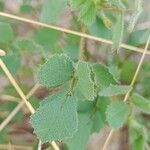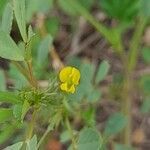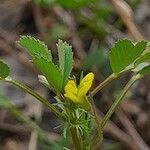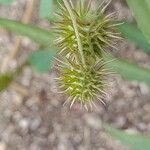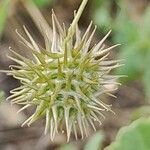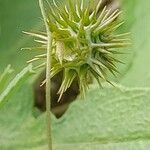Pod cylindrical to ellipsoid, usually glabrous, spiny; coils 3–7, turning anticlockwise, the broadest coil 3–5 mm in diameter, not strongly appressed to each other; surface of coils with numerous S-shaped radial veins, not anastomosing before joining the submarginal vein near to the dorsal suture; grooves between dorsal suture and submarginal vein of pod narrow (invisible in side view of pod); spines 2–4 mm long, with 2-rooted base, one root arising in the dorsal suture, the other in the submarginal vein, the longer ones hooked at the tip, divergent and intermeshing with those of adjoining coils.
Annual herb, 0.15-0.35 m long; branching from near base, stems prostrate; glabrous or sparsely pilose. Central leaflets up to 15 x 7 mm, cuneate. Stipules deeply incised or laciniate; lower surface covered by simple hairs. Flowers 4-6 mm long. Calyx with teeth shorter than tube. Petals: standard ovate; wings shorter than keel. Flowering time Sept.-Apr. Pod globular or cylindrical, coils 5-7; spines 2-4 mm long, grooved basally; without partitions between seeds.
Prostrate or ascending, sparsely hairy annual, up to 0.4 m long. Leaves 3-foliolate, leaflets obtriangular, 3-8-lobed or sometimes unlobed, apex notched, margins minutely toothed. Flowers 2, on a peduncle 10-20 mm long and continuing into a thread-like sterile tip, yellow, calyx hairy, lobes narrowly triangular, standard obovate. Pod loosely 3-7-coiled, with spreading straight spines hooked at apex, base grooved.
A small herb. It is an annual plant. The stems branch at the base. They lie along the ground. The leaves are compound with 3 toothed leaflets. These are hairy underneath. The leaflets are 6-12 mm long by 2-5 mm wide. The flowers are small and yellow. They are pea like. The fruit is a pod that is like a spiny ball. It has 5-7 coils. There are 8-10 seeds.
Leaves petiolate; leaflets 4–15 × 2–7 mm, narrowly cuneate-obovate or cuneate-oblong, truncate to retuse and apiculate at the apex, denticulate in the upper half or deeply toothed or irregularly laciniate, glabrous above, sparsely pilose beneath; petioles up to 2.5 cm long; rhachis up to 5 mm long; stipules laciniate, with simple hairs beneath.
Annual herb. Stems procumbent, up to 350 mm long. Leaves with central leaflets 4-15 x 2-7 mm; stipules laciniate or incised. Flowers: calyx teeth shorter than tube; wings shorter than keel; corolla yellow; Aug.-Nov. Burrs with 5-7 coils turning clockwise; spiny, without partitions between seeds.
Corolla yellow, twice as long as the calyx; standard ovate, longer than the keel; wings shorter than the keel; keel blunt, oblong.
Inflorescence 1–2-flowered; peduncle produced into an arista beyond the terminal flower.
Calyx 3–4 mm long, sparsely appressed-hairy; teeth equal, shorter than the tube, hairy.
Seeds 5–10 per pod, c. 3 mm long, oblong to subreniform, yellowish, smooth.
Flowers very small, with pedicels shorter than the calyx tube.
Spreading annual herb, branching from the base.
